Thankfully with a great team working together, we covered the prepared wall with the Beeck Quartz Filler quite rapidly. It is quite time consuming, mostly because of the dabbing action needed for such a bumpy surface, but we loved using the paint.
It was Mufti Day when we painted on the bridging primer, and so, as you can see, there is not a uniform in sight. Just as well really as the paint did tend to go in unexpected places….I have to say, not because the painters were not being sensible, its just the paint seemed to have a life of its own!
I have to say I was very impressed with how quickly those painters who worked with me picked up the way to control the paint…It is quite runny and it’s more like a stain, and so they sure did need to know how to control it!
The decking was very comfortable to sit on, and as you can see, we used rubber gloves to protect our hands and plastic goggles too. There’s nothing unsafe or toxic about the paint, it’s just very alkaline and I know from experience that it dries out your skin, and can sting, though I didn’t find this much with the paint, it was more just the fixative alone. In a school setting we have to do things properly though, and the goggles meant that there were no worries with regard to paint splashing in eyes. However, to be honest, one has to manipulate the paint in such a way that you wouldn’t tend to splash it about anyway.
I started the mural using the Beeck Silicate Mineral paints, and they were fine, but when I got to the linear parts I had discovered Keim Mineral Paints, and most particularly, their Soldalit, which is a third generation sol-silicate paint. This pain was much easier to handle..a very slight difference in consistency but it made all the difference with the lines. It was slightly more viscous. If I were to paint a mural like this again I would just use the Soldalit, as the difference in consistency made it easier to use.
From the Keim website:
Recent developments in mineral silicate paint technology have seen the introduction of sol-silicate mineral paintswhich not only utilise potassium silicate but also silica sol. Silica binders are ‘colloids’, a term originating from the Greek word for glue –‘kolla’. These particles have excellent viscosity, meaning they are well absorbed into a surface and once dry the particles firmly bind to the surfaces. The addition of the silica sol, enhances the already superior adhesion of mineral paints and increases their scope of use to include application onto previously painted surfaces.”
Yes, and an additional bonus, not utilised in this case, as it was silicate on silicate, but something which I will certainly experiment with in different contexts when the mural is done.
Again from the Keim Mineral Paint website:
Mineral Paints have a flat, matt finish, however the crystal structure provides excellent light reflectance which gives a bright, clean apperance. In addition, through the use of earth oxide pigments, there is no colour fade – proven on buildings which were been decorated over 100 years ago where there is still no visible colour fade and no breakdown of the coating itself. Keim Paints are inherently resistant to mould and fungal growth due to their high alkalinity, (pH is approximately 12.3), and therefore can provide long term resistance to mould and fungal growth.



